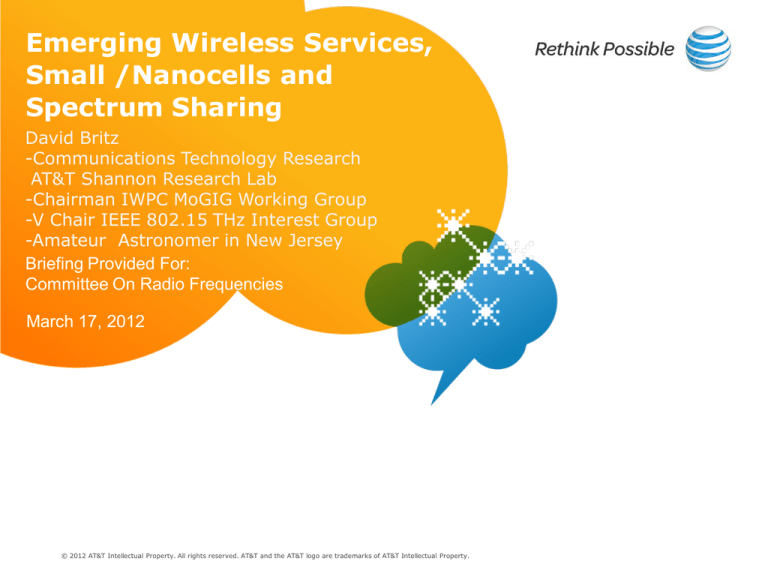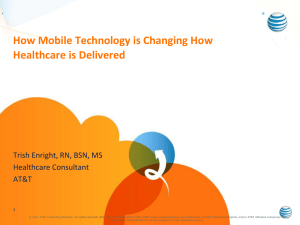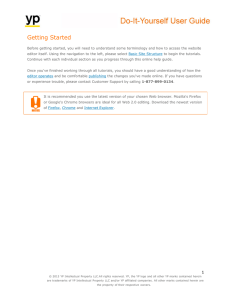
Emerging Wireless Services,
Small /Nanocells and
Spectrum Sharing
David Britz
-Communications Technology Research
AT&T Shannon Research Lab
-Chairman IWPC MoGIG Working Group
-V Chair IEEE 802.15 THz Interest Group
-Amateur Astronomer in New Jersey
Briefing Provided For:
Committee On Radio Frequencies
March 17, 2012
© 2011 RRM and AT&T Intellectual Property. All rights reserved. AT&T, the AT&T logo and all other AT&T marks
contained herein are trademarks of AT&T Intellectual Property and/or AT&T affiliated companies. All other marks
contained
are the
property of
their respective
© herein
2012 AT&T
Intellectual
Property.
All rightsowners.
reserved. AT&T and the AT&T logo are trademarks of AT&T Intellectual Property.
Cell Coverage Area Trends
The Incredible Shrinking Cell
•
•
•
•
•
Maritime
Mobile
HF Radio
Service
(~300 mi)
Increased Bandwidth Demand/User
Battery/Dissipation Device Constraints
Moore’s Law Radios
Increased Edge Intelligence
Distributed Control Techniques
1,000,000
100 Watts
1G
Macrocellular
Systems
10,000 mi2
(~8 mi)
100,000
700 mi2
Cell 10,000
Radius
(Feet)
MJ-MK
Mobile
Telephone
(~60 mi)
1,000
Metroliner
The 2G
Train
Telephone “Sweet Spot”
(~15 mi)
2.5G
Microcells
(~2 mi)
The 3G
“Sweet Spot”
The 4G
“Sweet Spot”
100
1960
1970
1980
Year
2
© 2012 RRM and AT&T Intellectual Property. All rights reserved. AT&T, the AT&T logo and all other AT&T marks
contained herein are trademarks of AT&T Intellectual Property and/or AT&T affiliated companies. All other marks
contained herein are the property of their respective owners.
1 Watt
100 mW
PCS
Microcells
(~0.5 -2 mi)
1950
10 Watts
2G Cellular
Expanded
Service
(~4 mi)
1990
4
WNAN/LAN
Nanocells
(~.06 -..5mi)
2000
SensorNets
BANs
2010
30 mW
2020
Mobile/
Portable
Maximum
Power
Output
Choosing The Right “Shannon Tool” for the Wireless Job
1000
Higher Rate, Lower
Velocity Discrete
Mobility
These frequency based PHY layers will all
5G VHS Wireless LANs operate and coexist simultaneously
Spectrum “AI” and Terahertz (100+ GHz)
for a very long time, rarely
anything is retired
Peak
Data
Rate
Megabits per Second/User
100
4G H/S Wireless LANs
2.4 & 5 GHz
4G Wireless MANsNANs
10
700 MHz, AWS (1.7 & 2.1), Cellular 800 MHz & 1.9
GHz, and 2.4 & 5 GHz
1
3G/MAN Fixed or Pedestrian
Various Bands
2/2.5G Wireless WANs
3G/MAN Mobile
.1
800 MHz, 1.9 GHz
2.5G Mobile/Pedestrian
10 feet
100 feet
1 mile
Reach
3
3G/802.16 Wireless WANs/MANs
© 2012 RRM and AT&T Intellectual Property. All rights reserved. AT&T, the AT&T logo and all other AT&T marks
contained herein are trademarks of AT&T Intellectual Property and/or AT&T affiliated companies. All other marks
contained herein are the property of their respective owners.
Wider Area,
Higher Velocity Mobility
10 miles
Spectrum future -Envisioning Interactive Sensor “Clouds”
Cellular Wide-Area, Wi-Fi
and Broadband Network
Connections with Local
M2M Sub-Networks
4
© 2012 RRM and AT&T Intellectual Property. All rights reserved. AT&T, the AT&T logo and all other AT&T marks
contained herein are trademarks of AT&T Intellectual Property and/or AT&T affiliated companies. All other marks
contained herein are the property of their respective owners.
New Generation of Wireless services
Where do we find spectrum for these emerging services and industry?
Sensor Networks
Low power, low to moderate data,
adhoc, and ubiquitous distribution,
network and peer to peer
Semi Smart M2M
Machine to Machine
Moderate power , moderate
to large data, network centric
Adaptive, super high capacity
M2M Cloud Networks
5
© 2012 RRM and AT&T Intellectual Property. All rights reserved. AT&T, the AT&T logo and all other AT&T marks
contained herein are trademarks of AT&T Intellectual Property and/or AT&T affiliated companies. All other marks
contained herein are the property of their respective owners.
Early 2000’s small “cell” Neighborhood Area Network
EcoPole installation* illustrating contrast between
neighborhood APs and conventional cellular base
stations / towers
Macrocell
Antennas
and Tower
EcoPoles
Macrocell
Base Station
*AT&T Research Florham Park Campus
6
© 2012 RRM and AT&T Intellectual Property. All rights reserved. AT&T, the AT&T logo and all other AT&T marks
contained herein are trademarks of AT&T Intellectual Property and/or AT&T affiliated companies. All other marks
contained herein are the property of their respective owners.
RF-Transparent “Radome”
(Covers antennas
and Access Points)
Multi-Gigabit Mobile Wireless Networks:
Where are We?
• Out of necessity, wireless service providers are beginning to meter data usage to conserve
spectrum resources in response to burgeoning demand for data connectivity.
• Cellular networks are evolving to smaller coverage area, higher teledensity cells to deliver
more bandwidth and to reuse spectrum more intensely.
• Even with aggressive network infrastructure investment, a new generation of users and
applications are continuing to challenge wireless network capacity: “always on”
multimedia-connected individuals and sensor clouds, 3D video, and augmented reality are
preparing to enter the mainstream.
• Current cellular/wireless LAN technologies and spectrum roadmaps may struggle to keep pace with
emerging wireless connectivity demands and evolving user behavior. Without new spectrum and
network architectural approaches it is unlikely that Gigabit wireless Common Air Interfaces in
high teledensity areas can arise.
• Years ago, AT&T-developed cellular microwave communications was a similar disruptive
concept that spawned many technological advances.
• Terahertz example: “Yesterday Once More”--- the 1930’s again!
−
−
−
−
−
7
Abundant bandwidth
Simple radios
Spectrum “AI” COG Radio control layer for small and nanocell wireless networks
New architectures
New applications
© 2012 RRM and AT&T Intellectual Property. All rights reserved. AT&T, the AT&T logo and all other AT&T marks
contained herein are trademarks of AT&T Intellectual Property and/or AT&T affiliated companies. All other marks
contained herein are the property of their respective owners.
Small CELL –near term
Physics, Shannon and operational efficiencies of existing cellular solutions are driving us to small cell
topography's using a combination of optical fiber and mmWave backhaul and small cell LTE customer
connection. These small cells will be deployed along city roads and public spaces, to optimize the capacity of
the small cell customers network connection .
Small cells may use mmWave frequencies (60-100GHz), for P to P backhaul routing of customer traffic and
inter-small cell management, to get ahead of and to minimize fiber costs. Reuse spectrum while scaling out
the small cell network to meet rapidly growing demands for wireless data (80 fold in four years).
• Expands upon cell splitting approach to optimize local area wireless capacity. Small cells look like
regular cells to the MAC control layer , but issues of rapid customer transits (small cell) and hand-off
concerns may limit scalability - some level of localized edge intelligence may be required
•Small cells will need to utilize redundant wireless and fiber mesh configurations to minimize aerial
conduit obstructions
•Small cells comply with existing Cellular and Wi-Fi infrastructure, as part of an OFF LOAD HetNet
“shaped network” architecture
•Small cells may be deployed quickly utilizing existing lessons learned from existing standards and
deployment methods, requiring a minimal industry learning curve.
BUT …….
•Small cells will require low cost high volume mmWave, solutions for network connecting backhaul.
•Small cell architecture will need to spectrally coexist with other users both active and passive within
the “operational “space . But what is the operational space …….Spectrum AI?
8
© 2012 RRM and AT&T Intellectual Property. All rights reserved. AT&T, the AT&T logo and all other AT&T marks
contained herein are trademarks of AT&T Intellectual Property and/or AT&T affiliated companies. All other marks
contained herein are the property of their respective owners.
NANO CELL – longer term
Evolving wireless network technologies and services as well as the “Shannon limit” will drive future wireless networks
beyond small cells and toward the efficiencies of “shaped” wireless Nanocells networks. Networks designed to utilize
mmWave and THz frequencies (above 100GHz ), for both inter-nanocell backhaul as well as mobile customer connectivity.
•Conceived as a third PHY layer overlay to existing Cellular and Wi-Fi infrastructure, as part of an
OFF LOAD HetNet “shaped network” architecture
•Redirects “Big Data” from Network and cellular PoP’s to a parallel nanocell layer, potentially returning
current data dedicated cellular spectrum back to voice applications
•Intelligent edge (small coverage area) nanocells work in concatenated clusters that follow the customer
- and provide localized edge based handoffs due to mobile customers short duration within the nanocell
•Spectrum coordination between Nanocells and the nanocell-to-customer handset can be optimize for spectrum
usage and service type, using COG based spectrum AI and software defined radio and mulit-band
(MHZ, GHz, THz) front end radio
•Using high -frequency mmWave and THz spectrum , nanocell Super channels will be capable of
transporting and delivering 10-100Gbps wirelessly
BUT …….
•MmWave, THz and optical based nanocells will require “low interference “high gain antennas and micro
sectored or active beam steering to maintain dynamic link with customer and inter-cell backhaul
•Nanocell architecture needs to spectrally coexist with other local users, both active and passive, define local………..
•What lessons, if any, can be learned from existing cellular / Wi-Fi standards and practices to support
spectrum sharing and coexistence?
9
© 2012 RRM and AT&T Intellectual Property. All rights reserved. AT&T, the AT&T logo and all other AT&T marks
contained herein are trademarks of AT&T Intellectual Property and/or AT&T affiliated companies. All other marks
contained herein are the property of their respective owners.
Shaped Wireless Small Cell Aerial
Networks
Use the street and pedestrian areas as conduits for
mmWave /FSOC wireless backhaul between small cells,
and small cells mounted on AC powered street furniture
to avoid costly optical fiber deployments to every small cell.
10
© 2012 RRM and AT&T Intellectual Property. All rights reserved. AT&T, the AT&T logo and all other AT&T marks
contained herein are trademarks of AT&T Intellectual Property and/or AT&T affiliated companies. All other marks
contained herein are the property of their respective owners.
Shaped Nanocell
Networks
Small Cell –
mmWave backhaul
Moving from cellular omni and
sectored emission to steerable
mmWave and THz directional
beams
11
© 2012 RRM and AT&T Intellectual Property. All rights reserved. AT&T, the AT&T logo and all other AT&T marks
contained herein are trademarks of AT&T Intellectual Property and/or AT&T affiliated companies. All other marks
contained herein are the property of their respective owners.
NanoCell
mmWave/FSOC backhaul
Small Cell
Topography
Nanocell
Topography
12
© 2012 RRM and AT&T Intellectual Property. All rights reserved. AT&T, the AT&T logo and all other AT&T marks
contained herein are trademarks of AT&T Intellectual Property and/or AT&T affiliated companies. All other marks
contained herein are the property of their respective owners.
http://www.ieee802.org/15/pub/IGthz.html
Don Brown
Director, IWPC
600 Louis Drive
Suite 104
Warminster, PA 18974
TEL: +1 (215) 293-9000
donbrown@iwpc.org
http://www.iwpc.org/
Active mmWave and THz
Industry and Standards
Organizations
13
© 2012 RRM and AT&T Intellectual Property. All rights reserved. AT&T, the AT&T logo and all other AT&T marks
contained herein are trademarks of AT&T Intellectual Property and/or AT&T affiliated companies. All other marks
contained herein are the property of their respective owners.
2010 THz Astronomy presentation
to 802.15 THz IG
2011THz Remote Sensing
presentation to 802.15 THz IG
2012 IEEE 802.15 THz IG Presentation and IEEE
Transactions TERAHERTZ SCIENCE AND TECHNOLOGY
Paper to be released 2012
14
© 2012 RRM and AT&T Intellectual Property. All rights reserved. AT&T, the AT&T logo and all other AT&T marks
contained herein are trademarks of AT&T Intellectual Property and/or AT&T affiliated companies. All other marks
contained herein are the property of their respective owners.
Case scenarios analyzed
for Interference
15
© 2012 RRM and AT&T Intellectual Property. All rights reserved. AT&T, the AT&T logo and all other AT&T marks
contained herein are trademarks of AT&T Intellectual Property and/or AT&T affiliated companies. All other marks
contained herein are the property of their respective owners.
So how do we move forward?
•Evolving wireless communications, societal and customer demand, and expanding
technology based wireless services will place unprecedented demand on existing and
emerging wireless networks and spectrum utilization.
•Mobile wireless services has already become a societal structural element! An
societal element as important to the very fabric of our society as are electricity,
water, homes and highways
• Wireless mobile communications has also become a societal force that will demand
government, sciences and industry work together to solve spectrum sharing concerns.
16
© 2012 RRM and AT&T Intellectual Property. All rights reserved. AT&T, the AT&T logo and all other AT&T marks
contained herein are trademarks of AT&T Intellectual Property and/or AT&T affiliated companies. All other marks
contained herein are the property of their respective owners.
So how do we move forward?
As a community of regulatory and Industry, standards and radio technology
experts need to figure out;
•A common sense and commercially viable approach for cooperative sharing of spectrum
for both active and passive services, its’ no longer a convenient sound bite,
it’s now a societal imperative!
•How can active services cost effectively protect passive service spectrum and operation?
•How can passive services share spectrum with active services safely and cooperatively?
•Perhaps the emerging intelligent edge network, and small cell/nanocell approach,
provides us the best chance to rethink things – especially localized real-time adaptive
spectrum usage and management, perhaps even COG based Spectrum AI?
•Perhaps the active and passive services communities can work together, share ideas and
collaborate to a solution ? How? What's the mechanism to provide this venue and
ongoing dialogue. How do we enact standards to reflect these solutions?
17
© 2012 RRM and AT&T Intellectual Property. All rights reserved. AT&T, the AT&T logo and all other AT&T marks
contained herein are trademarks of AT&T Intellectual Property and/or AT&T affiliated companies. All other marks
contained herein are the property of their respective owners.
One last thought!
The emergence of Small cells and eventually Nanocells ,
may represent one of the last opportunities to get it right!
By designing in, at the beginning, the critical active and
passive spectrum coexistence and sharing solutions.
Lets use this new network topography opportunity
to work together to find solutions that work for all.
18
© 2011 RRM and AT&T Intellectual Property. All rights reserved. AT&T, the AT&T logo and all other AT&T marks
contained herein are trademarks of AT&T Intellectual Property and/or AT&T affiliated companies. All other marks
contained herein are the property of their respective owners.
Need More Information?
David Britz
Communications Technology Research
AT&T Shannon Laboratory
Florham Park, NJ
+1 973-236-6913
dbritz@research.att.com
19
© 2011 AT&T Intellectual Property. All rights reserved. AT&T and the AT&T logo are trademarks of AT&T Intellectual Property.




